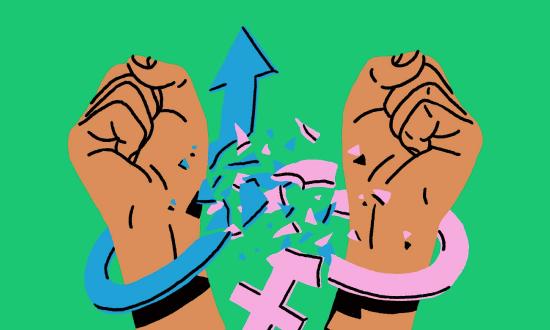5.10: Policing of Gender in the United States
- Page ID
- 167816
Sociologists who study gender are often interested in the factors that shape people’s performance of gender based on social cues. As mentioned earlier, sociologists West and Zimmermman (1987) theorized this concept of “doing gender.” “Doing gender” per the sexual scripts means that we fall into two distinct categories, and our behaviors must reflect what the culture defines as gender appropriate behavior. When the script is not followed, we are reminded that we are not staying in our gendered lane, and are sanctioned in some type of way. Gender policing is the enforcement of heteronormative gender ideals that force the gender binary onto people. “Masculinity” and “femininity” are often rewarded by people who reject the idea that gender is a social construct which lies on a spectrum. As a result, performances that differ from normative cis-gendered stereotypes are generally rejected from patriarchal, heteronormative society.

.jpg?revision=1&size=bestfit&width=340&height=222)
The ways that gender is ‘policed’ can range from microaggressions to macro-aggressions. Boys are policed at a young age for expressing stereotypical feminine traits. While young boys are generally policed more visibly than young girls early on, girls are asked to perform gender in ways that may be less visible, but are no less impactful. Being taught that their physical appearance is a basis for validation, or to defer to others' feelings, or take up less physical space, or be nice to people even when they don’t feel like it teaches young girls to accept unwanted treatment or behavior. Repercussions of this type of role expectation can lead to young girls putting up with harassment or abuse, or being hypercritical of their bodies and starving themselves to fit into cultural standards of beauty because they have been socialized to put their wants and feelings aside to make others happy.
Gender policing into two distinct categories means that we learn very different cultural scripts (again, most policing takes place within the false binary so this is where we focus attention). As a result the definition of sexuality gets filtered through a gendered lens. Looking back to the author’s own research on sex education and gender, we saw that parents have two very different expectations of their children sexuality, depending on their gender. When many of these humans come together in sexual or relational partnerships, they enter in with a completely different narrative of sexuality, consent, and communication. Right off the bat, this means in order to make things work, there is a lot of unlearning to do about sex and relationships.
Sociologists also note that gender policing exists at all periods of a person’s life, and shows itself at the intersection between race and class. Intersectionality, allows for an understanding of how a person’s social and political identities combine to create different modes of discrimination and privilege. The ways in which all of our different aspects of self-interact with our gender can affect the type, degree and severity of gender policing. An intersectional approach is important when looking at the impact of gender policing.
From a very early age I remember knowing that thin was good, fat was bad. My parents were immersed in society’s idea that we were supposed to be thin and not take up too much space. Be thin. Look fit. My mom said to me once that when she was pregnant her doctor told her that she should only gain 20 lbs. So, she only gained 20lbs. Thinness wasn’t about health, it was about acceptance. When I was a young child I never thought about how my body looked. It was just the vessel I used to run, play, go on adventures. When I was 11 I started to grow a lot. I became much taller than my friends. Soon after I began my period. I had no idea what to do or how to accept this. There was so much shame. We didn’t talk about what menstruation was or why we go through it. It was just shameful. I remember a conversation with my friend one day when she recognized that I had grown so much. “How much do you weigh”, she said. I didn’t think anything about it. It was arbitrary, at least that’s what I thought. “I weigh 80lbs”. She was surprised. "I only weigh 50lbs”. That was the first moment that I felt ashamed of my size. I was the big girl.
As my body continued to change into my teens, my hips grew, my boobs grew. I was being transformed into a sexual being. It was the most confusing time. As I was being told to remain a good girl, the world was treating me like a prize up for grabs. It was totally normal for people to comment on how your body looked. My body was no longer mine. It belonged to society, my parents, my boyfriend, random people. It’s hard enough to embrace your body as it changes throughout your life, the last thing a person needs is scrutiny from others.
Thank God for my fifties. I no longer have to be sexy. I am no longer in a position to get pregnant. I don’t need a partner. At first letting go was a challenge, but the more I let go the better I feel. I can love my body as it is. I can respect it for what it has given me and done for me. I love my soft saggy belly and my flappy “Hi Helen” arms. And I am very grateful for all the things I still get to do that bring me joy.


